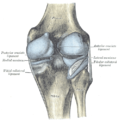Fibular collateral ligament
| Fibular collateral ligament | |
|---|---|
 Left knee-joint from behind, showing interior ligaments. (Fibular collateral ligament labeled at center left.) | |
| Details | |
| From | lateral condyle of the femur |
| To | head of the fibula |
| Identifiers | |
| Latin | ligamentum collaterale fibulare |
| TA98 | A03.6.08.011 |
| TA2 | 1895 |
| FMA | 9660 |
| Anatomical terminology | |
The fibular collateral ligament (long external lateral ligament or lateral collateral ligament, LCL) is a ligament located on the lateral (outer) side of the knee, and thus belongs to the extrinsic knee ligaments[1].
Structure
Rounded, more narrow and less broad than the medial collateral ligament, the fibular collateral ligament stretches obliquely downward and backward[2] from the lateral epicondyle of the femur above, to the head of the fibula below. In contrast to the medial collateral ligament, it is fused with neither the capsular ligament nor the lateral meniscus.[3] Because of this, the lateral collateral ligament is more flexible than its medial fellow, and the latter is therefore more susceptible to injury.[2]
Both collateral ligaments are taut when the knee joint is in extension. With the knee in flexion, the radius of curvatures of the condyles is decreased and the origin and insertions of the ligaments are brought closer together which make them lax. The pair of ligaments thus stabilize the knee joint in the coronal plane. Therefore damage and rupture of these ligaments can be diagnosed by examining the knee's mediolateral[4] stability. [2]
Immediately below its origin is the groove for the tendon of the Popliteus.
The greater part of its lateral surface is covered by the tendon of the Biceps femoris; the tendon, however, divides at its insertion into two parts, which are separated by the ligament.
Deep to the ligament are the tendon of the Popliteus, and the inferior lateral genicular vessels and nerve.
Notes
References
- Platzer, Werner (2004). Color Atlas of Human Anatomy, Vol. 1: Locomotor System (5th ed.). Thieme. ISBN 3-13-533305-1.
- Thieme Atlas of Anatomy: General Anatomy and Musculoskeletal System. Thieme. 2006. ISBN 1-58890-419-9.
Additional images
-
Capsule of right knee-joint (distended). Posterior aspect.
External links
- The KNEEguru
- lljoints at The Anatomy Lesson by Wesley Norman (Georgetown University) (antkneejointopenflexed)
![]() This article incorporates text in the public domain from page 341 of the 20th edition of Gray's Anatomy (1918)
This article incorporates text in the public domain from page 341 of the 20th edition of Gray's Anatomy (1918)

